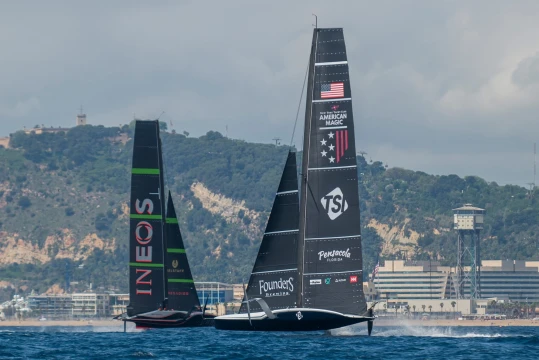
America's Cup: busy Barcelona as the grind gets real
America's Cup: busy Barcelona as the grind gets real
From the recent days of relatively calm sailing, today Barcelona reminded all involved in the Louis Vuitton 37th America’s Cup that it’s a venue to be treated with caution and respect as a residual southerly swell mixed with a sharp north-easterly wind chop that filtered in and whipped up a mean average of 1 metre waves to make it interesting. Still in the grips of the slow-moving Atlantic high-pressure system however, winds were in the 7-13 knot range but at the upper end it showed just how potent the new AC75 designs really are.
INEOS Britannia and NYYC American Magic selected their weather windows and executed long sessions, overlapping for a while, and showing some of the most thrilling sailing we’ve seen so far - and all pretty much on the same stretch of water. Orient Express Racing Team were also out in their AC40, tearing around and making the necessary gains ahead of their AC75 launch at the end of the month and looking impressive. Busy is getting busier and with Luna Rossa Prada Pirelli on their way, Barcelona is about to explode into an America’s Cup bonanza like no other.
For NYYC American Magic it was a super-early start with the team really wanting to put the last two days of stop/start, short sessions, behind them and they were off the dock smartly at just before 8am with many of the team onsite before 5am. Once out, there was some major thought over jib selection with the J2 being replaced by the J3 and this pattern continued with the J1 being added mid-session and then quickly replaced.
Race laps at pace were the order of the day initially before some dynamic pre-start action that the on-water recon team saw as being near-perfect time-on-distance. A few teething tech issues and monitoring of the 3D jib system occurred but this was a valuable day of training that will have extracted plenty of useful data from the heavily camera'd starboard foil that seems very much in focus with American Magic at the moment.
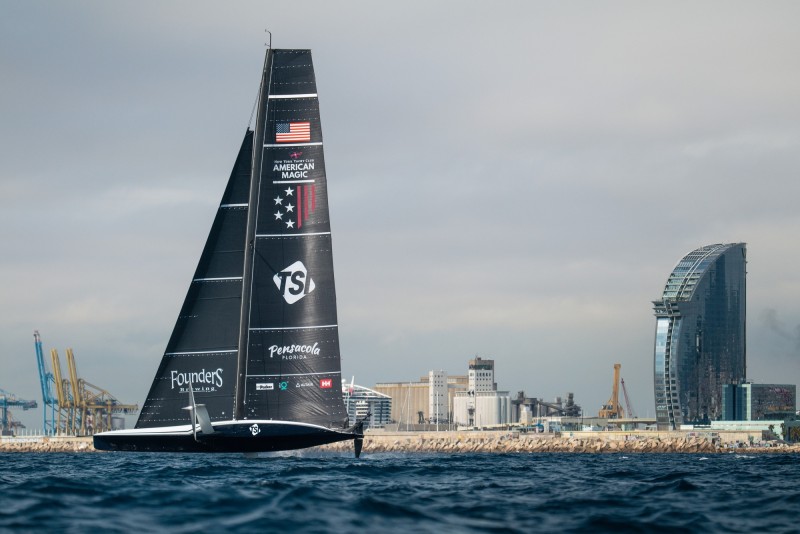
Tom Slingsby and Paul Goodison are gelling into a super-effect partnership with some good hand-overs through the manoeuvres and a smoothness that is the mark of the very best but where American Magic have struck gold is in the trim and flight control departments with Andrew Campbell and Michael Menninger looking world class. Flight was rock solid, a 95% foil-to-foil ratio is not to be sniffed at and their responsiveness through the lulls and shifts was exemplary. The whole afterguard package on American Magic just looks so in tune with each other and this could be key when they put it all on the line at the Louis Vuitton Cup in less than 100 days’ time.
Speaking afterwards, Trevor Burd one of NYYC American Magic’s elite cyclors and a hugely popular figure within the team, summed up the day, saying: “Early start, we were just focused on getting the most out of the breeze today and capturing the window that we had so there's more about getting the reps in just maximising the whole day as much as we could...(the boat) actually performed really well today, really happy with how everything went, there's obviously these little gremlins pop up but nothing that we couldn't handle in a few minutes and no problems there.”
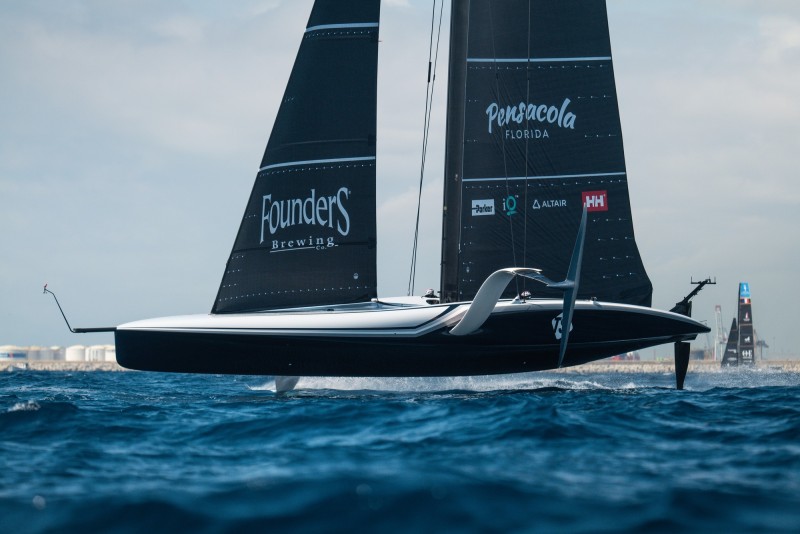
Trevor then went into a fascinating exchange with the recon team that gave an insight into the cyclor’s world. The recon team had spotted a distinctive display in one of the cyclor pods and quizzed Trevor further: “Not every cycling pod has a control panel like we've got in that one cockpit, everyone’s got buttons and some functions they can they can work with, but that one there is just kind of system functions and some basic setup things...there's not a lot of differences, we've all got our own custom seats to make sure we can really put the power down how we need to and get comfy in the cockpits, that's been really important for us, but the actual cockpits are basically the same...each guy has their own display that gives us just some information on some line pressures, accumulator pressures, and some boat data just letting us know when we need the power and when we're able to back off for those split precious seconds...we've got comms between the whole group and so if we need to speak up we can chip in, but for our group it's mostly listening to what the guys at the front of the boat are saying and so we can be really tuned in especially in when doing race simulation and race practice...just talking about times to boundaries, if we're in a pre-start with the plan is, what manoeuvre might be coming up next and then a little longer term if we're doing three tacks and a bear-away or it's one and in - just kind of general race comms.”
And talking about the recumbent cyclor position and what the team are learning on a daily basis, Trevor added: “There's definitely been some learnings on the recumbent side...no one's really put a recumbent bike on a sailboat before so we had to learn a lot about our position, what gear we wear, and about our mechanical set-up of what works well, what doesn't, it's a new challenge that not a lot of people have faced so it's been really interesting and rewarding try to tackle that.”
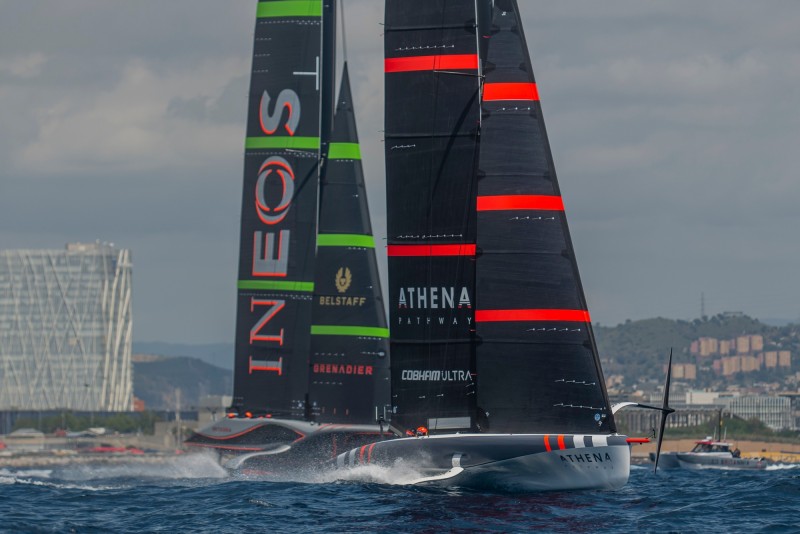
RB3’s stability is remarkable, converting every ounce of power from the rig into straight-line speed capable of taking on anyone in a drag race to the boundary. The new aero strip that runs off the aft counter is a nod to just how aero-sensitive the design team believe the new generation of AC75’s are, and it will be fascinating to see how this overall package develops in the coming weeks and months.
Docking out at 9am sharp, the team knew that they wanted a big performance through the morning and into the building breeze. They didn’t disappoint with over 100 miles covered in effectively four-and-a-half hours of foiling time. A total of eight upwinds were completed and the sailors just looked ‘on it’ all through the session. Tacks were sharp and flat with high technique whilst downwind, the gybing was just epic with deep VMG on the exits and plenty of power being exuded through some dynamic trim. INEOS Britannia’s skinny foils, still running the Pitot tubes off the front of their stubby bulbs, looked to be working a treat and as the session wore on, it was noticeable that cant angles were being tested hard. There’s plenty of performance to come from this platform as they wind it up to the max. Impressive...again.
Speaking afterwards, Chief Designer for INEOS Britannia, Martin Fischer, spoke at length to the recon team and although guarded about ongoing development, gave a superb interview that started with asking whether he agreed with many commentators that the RB3 design is perhaps the most potent of them all: “Of course! But no, we don't know yet. We're quite happy with where we are, we think that we put together a quick package, but I guess all the teams think that, so the truth will come out when we line up for the first time with the others so at the moment we don't know.”
When drawing a comparison between the American Magic low volume approach and RB3’s more muscular side-walling, Martin opined: “We think that our approach is the right one. The design approach is obviously quite different, so I think the Americans tried to reduce as much as possible the frontal area to reduce drag, we also looked in that direction, but we think we found a slightly different way that we think works better.”
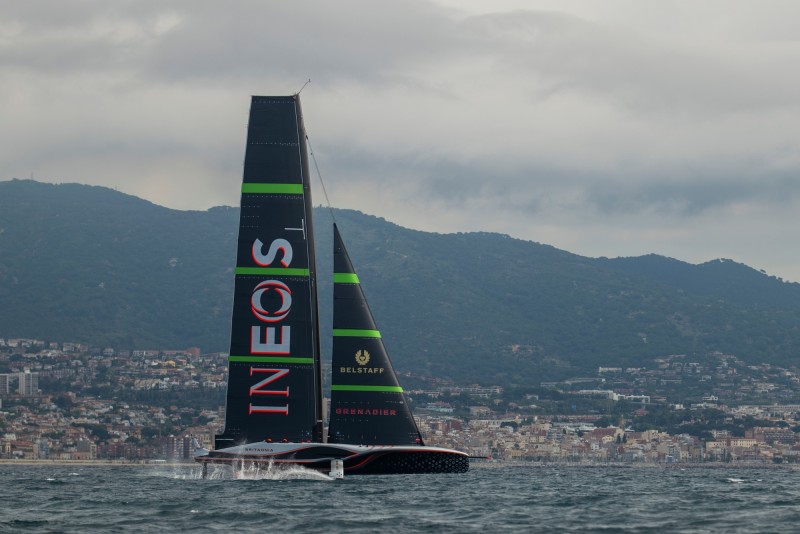
And asked directly to comment about the speculation around the rudder potentially adding stability through rake, Martin have this insight: “I think all the teams are doing more or less the same thing so the distance of the rudder with respect to the foil is not a big deal, it is the weight distribution of the boat and where the foil sits with respect to the centre of gravity is much more important and that's of course something we cannot see on a boat because we don't know where the centre of gravity is, we know only where the foil is but I assume that all the teams are following a pretty similar path there.”
Big day tomorrow for INEOS Britannia with the official naming ceremony taking place at the team’s Port Vell base in Barcelona and there’s plenty of interest swirling around the Challenger of Record’s assault on this Louis Vuitton 37th America’s Cup. They’re looking more than good at the moment. (Magnus Wheatley)
On-Water Recon Report – NYYC American Magic: American Magic rolled out Patriot at 05:35 in an effort to catch the morning breeze. Following a 06:05 crane in, standard checks were carried out before dock-out at 07:55. The MN2-1 mainsail and J2-1 jib were hoisted under the breakwater, with the J2 subsequently replaced with the J3-1 jib just before setting sail at 08:40. A residual south swell combined with 10 knots avg. wind chop from the NE made for an aggressive sea state, but not large enough to impact sailing on foil.
The team started off testing the starboard foil, still with cameras mounted to the top and bottom outboard surfaces of the foil, was carried out at varying angles, from very high and slow, to low and fast. Following these tests, the team sailed down to the leeward gate and completed a lap of the 2NM windward/leeward course, set at 55 deg. Racecourse practice commenced at 09:30, with Patriot entering on port and sailing two laps of the course, finishing with a JK manoeuvre round the leeward gate, as technicians jumped onboard and headed below deck. A second pre-start was practiced, entering on port, and performing a 360 turn (tack and gybe) after the start. This start was not on GPS time. Following, the J3 was exchanged with the J1, as cyclors also rotated.
A third start (port entry), continued into two laps of the course, with a touch down noted on approach to rounding the leeward gate after the first lap. The J1 was exchanged back to the J3 ahead of one practice pre-start (starboard entry) and a final start (port entry) which was subsequently abandoned. Sailing resumed, with an apparent focus on the jib system, as the team sailed a final upwind leg, before turning downwind and continuing to the port to end the sailing day.
Sails were dropped by 12:30 and the team docked in at 12:40, after just under five hours on the water, of which 155 minutes were spent sailing, divided into seven stints. 80 manoeuvres were observed, with a fully foiling rate of 95%. All starts (on GPS time) were clear and on time.
On-Water Recon Report – INEOS Britannia: Team INEOS Britannia rolled out RB3 at 07:00 today and craned in at 07:45 after some regular checks and maintenance on the different aero and flight control systems. Today just the camera from starboard side foil was seen installed. LiDAR cameras for main and jib sails were also onboard.
Dock out was at 09:00 and RB3 was towed to the entrance of the harbour where sails were hoisted. Mainsail MN1 was hoisted, paired to a J3 jib. A wind of about 7-8 knots TWD 50 º @09:25 was blowing at that moment but rapidly increased to 10-14 knots. The sea state was about 0.8-1.3 m and grew a little bit more after midday.
Around 8 upwinds and downwinds with legs of different lengths were sailed today and also some reaching courses were completed. It was the first day that we could see RB3 sailing with medium winds from the NE direction with its respective tricky wave-state. We could see the boat flying higher as per we are used to with the SW winds and flatter waters of yesterday, and delivering a high percentage of clean manoeuvres.
Starboard tacks and gybes were found to be a bit faster than port side ones, we thought it could be due to the wave direction but most probably it was just because of the camera that is located on the starboard side foil.
Upwinds were sailed at about 45-50º and down winds at about 140º to the wind. Three cyclor swaps were done: first at 11:00 (after 1 hour 15 min of effective sailing), second at 12:00 (after 1 hour of effective sailing) and third at 14:50 (after 1 hour 15 h of effective sailing). Batteries were changed at 13:00 when also the jib J3 was replaced by jib J2 (9-11 knots TWD 75º @14:00). This stop took almost one hour. At this moment also Dylan Fletcher got onboard as a backup to Ben Ainslie as a starboard helm.
When sailing with the J2 very similar upwind and downwind angles were seen but it was in the tack manoeuvres were we could see a lower performance than when sailing with J3.
Sails were dropped at 15:20 and dock in was done at 15:50 for INEOS Britannia team.
As a summary 100 miles, 4 h 30 minutes approximately of fully foiling were sailed today in around 8 upwind-downwinds with long straight lines, 33 tacks (2 touch and go and 1 touchdown) and 26 gybes, almost all of them fully foiling. Some reaching courses were also done and diverse upwind and downwind round markings were also completed. Jose Luis Piñana – INEOS Britannia AC Recon







